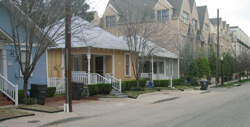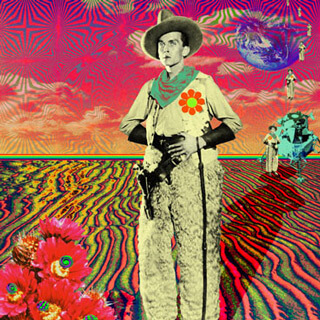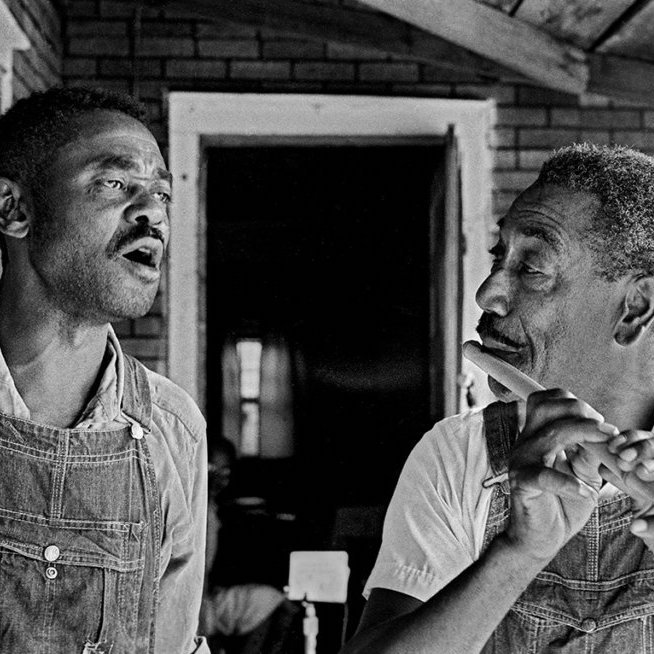Overview
"Deep Ellum Blues" expands upon the author’s narrative of growing up in suburban Dallas, Texas, to explore the relationship between the city’s Sunbelt sprawl and the fate of historical African American neighborhoods, particularly Deep Ellum and North Dallas’ Freedmantown. Deep Ellum, along with its legendary music scene built by the likes of Blind Lemon Jefferson, Blind Willie Johnson, Lead Belly, and Bill Neely, all but disappeared with the construction of Central Expressway in the 1950s. It has since returned as a largely white center for alternative culture. Freedmantown has re-emerged as the gentrified "State-Thomas." These neighborhoods register the city’s changing racial geography and obliteration of history.
Introduction
The railroads made Dallas, Texas into a city, highways made it a Sunbelt city, and DFW Airport made it an international city. Never much known for making things, it has been a place where products are financed, brokered, and transported: leather and buffalo hides in the first place, followed by cotton and oil, clothing and technology. In fact, as Dallas historian A. C. Greene has astutely observed, land development has always been the city's chief industry: "When the Republic [of Texas] joined the United States in 1846 it retained ownership of all its public land, making the State of Texas the nation's largest land promoter, aside from Uncle Sam himself. And in Texas, no city was so conceived and created as a real estate promotion, and no city has been so controlled in its civic and municipal directions by land development, as has Dallas."1A. C. Greene, “Introduction,” in William L. McDonald, Dallas Rediscovered: A Photographic Chronicle of Urban Expansion, 1870-1925 (Dallas: The Dallas Historical Society, 1978), v. Almost nothing, neither geography nor government, constrained the growth of the city, and it has thrown its tract developments of ranch houses far and wide across the prairies of North Texas, becoming one of the archetypes of Sunbelt sprawl.
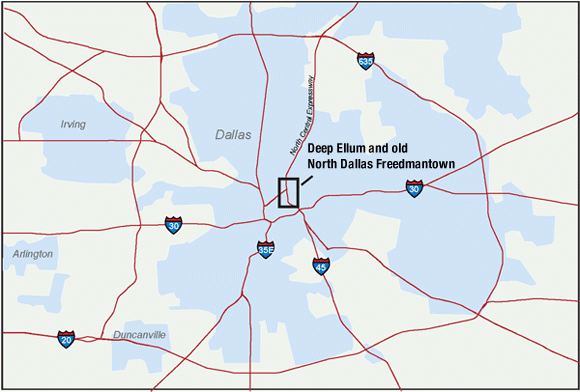 |
| City of Dallas and Deep Ellum Area |
This hyper-American model of speculative growth has left little room for the old, at least until very recently. For such a young city, the new becomes the old, unwanted, and forgotten very quickly. Particularly unwanted have been the neighborhoods marked by the presence of African Americans in Dallas: Frogtown or Froggy Bottom (an early mixed neighborhood of shady character adjacent to the Trinity River and its thousands of serenading frogs), Stringtown, the North Dallas Freedmantown, and Deep Ellum have all been plowed over by development, even if the latter two have known recent re-development. Legal desegregation, in fact, only heightened this process since it made it appear even more necessary for white Dallasites to live further from the center city.
African Americans were present in the Dallas area as slaves before the Civil War (97 out of a total population of 678 in 1860), but many more arrived soon after the war, and settled in a variety of 'Freedmantowns' around the city. One of these Freedmantowns remained in the far north of the city in my own childhood in the 1960s and 70s although I did not recognize it as such at the time. It was simply an old cluster of small houses and farms gathered around a church on Preston Road near what is now Alpha Road, just north of Valley View Mall (which valley? what view?). No one ever mentioned the circumstances of this place to me; probably almost no one outside the community itself knew its history. We lived in the present of suburban Dallas; the Freedmantown existed in its past. This was not strange in itself. There were still cotton fields very close to my suburb of Richardson in those days, and a Sunday drive in almost any direction would turn up numerous little farming communities, white and black. These communities sometimes co-existed in space with the northern suburbs of Dallas, but they seemed to occupy another time altogether.
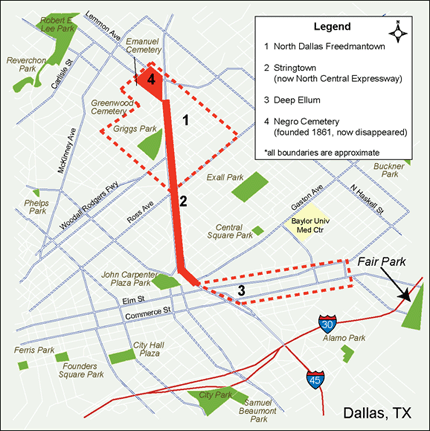
Area of Dallas Discussed in This Essay (Showing Historical Boundaries)
Discovering Deep Ellum
Driving through other parts of the city of Dallas itself produced another and more unsettling effect: neighborhoods that were certainly not rural, but just as certainly not the grittier world of Shaft that I saw in the movies or on television. Instead, what I saw in the poorest black neighborhoods were usually shotgun shacks, often with trees in the front and backyard gardens, sometimes even a chicken or two, along with the odd public housing project, small and squat, built around a desolate courtyard. Somewhat more urban was the neighborhood just north of downtown Dallas that, I found out only much later, had once been another Freedmantown. Hall Street around State and Thomas Streets had once been the heart of the North Dallas Freedmantown, populated by black servants (there were prosperous white homes on Thomas), merchants, and professionals. By the 1930s and 40s, the area was also a center of entertainment, filled with black nightclubs including the Empire Room, where Ray Charles frequently performed early in his career, and the Powell Hotel and Court, where Duke Ellington stayed when in town. I think that I only drove through the center of this neighborhood once, in the early 1970s, when my family was probably trying to get to something like the newly developed Quadrangle, an elegant new shopping development just a few blocks away in the Oak Lawn district. Perhaps a wrong turn was taken, and we approached Oak Lawn along the unaccustomed route of Hall Street, which looked devastated in this neighborhood — one or two stores hunched forlornly among vacant lots.
Just a mile or so to the south and east of this neighborhood, I saw the black neighborhoods around Fair Park, neighborhoods which I understood to be South Dallas (i.e. black Dallas), two or three times a year: on a trip to the Texas State Fair in October, a Dallas Cowboys (when they still played at the Cotton Bowl) or SMU Mustangs game, or one of the museums in Fair Park. On one such trip in the early 1970s, for reasons that I can no longer remember and probably never understood, I was bundled off to the Fair Park Bandshell for a weekend afternoon to watch the Grateful Dead or perhaps a band doing some Grateful Dead covers. (It's possible that my mother, who was at that time slightly hippie and listened to Joan Baez, thought this would be culturally improving in some fashion, which it probably was.) It's hard for me to believe that it was the Grateful Dead themselves since there were only a few dozen people in attendance, and I can find no reference to their ever having played at the Fair Park Bandshell around 1970 or 1971, when I saw this concert. The band, whatever it was, certainly played the Dead's "Casey Jones" because the shockingly exciting lyrics, "Driving that train, high on cocaine / Casey Jones you'd better watch your speed," have for me remained ever since attached to that time and place.
I have no clear recollection of any other songs played that afternoon. I would like to believe that the band was the Grateful Dead and that they played "Deep Elem Blues," a staple of their performances (never recorded in studio), only because they would have been as close to the neighborhood of Deep Ellum as they ever performed. (My Deadhead friend, John Berto, tells me that there is no record of band ever playing the song in the state of Texas, much less Dallas.) Deep Ellum was on the east fringes of downtown Dallas, the "deep" or far side of Elm Street, between the Central Expressway and Fair Park. We passed through Deep Ellum several times without ever knowing its name; nor would the name have been particularly meaningful to me if I had known. In the 1960s and 1970s, the area seemed to have no name or history.
 |
| Honest Joe's Pawn Shop, Deep Ellum, 1959. |
It was simply a warehouse and pawnshop district, completely empty on the weekends, which we drove through with the complete conviction, at any rate on the part of the kids in the car, that stopping too long would mean death. The pawnshops themselves were even more disreputable, it seemed, than the ones closer to downtown, since I remember that at least one prominently featured both guns and hubcaps. I was probably viewing the latter-day incarnation of Honest Joe's Pawnshop, owned for years by the Ruben "Honest Joe" Goldstein and his son Eddie.
Another member of the family, Isaac "Rocky" Goldstein, later gained brief fame by selling David Hinckley the gun used to shoot Ronald Reagan. I know this fact about Rocky Goldstein only because he was also a source for Alan B. Govenar and Jay F. Brakefield's book, Deep Ellum and Central Track: Where the Black and White Worlds of Dallas Converged, which provides a goldmine of information about the place, including the role of small-scale Jewish merchants in the neighborhood.2Alan B. Govenar and Jay F. Brakefield, Deep Ellum and Central Track: Where the Black and White Worlds of Dallas Converged (Denton: University of North Texas Press, 1998). Much of my historical information in the first two paragraphs in "Blues History and Urban Life" is derived from their book. Govenar and Brakefield's book recreates the neighborhood in its heyday, when it was one of the major entertainment districts of the black South and proving grounds for the Texas blues. Blind Lemon Jefferson, Lead Belly, Blind Willie Johnson, Mance Lipscomb, Alex Moore, and T-Bone Walker all spent formative years there, and Moore lived long enough (1989) to become a source for the history of the area.
Blues History and Urban Life
Dallas's economic growth began with the arrival of the Houston and Texas Central Railroad in 1872, followed by the Texas and Pacific Railroad in 1873. From an early moment less reputable saloons began to operate around the H&TC station on the eastern edge of Dallas, which later became known as Central Track, and attracted a variety of cowboys, farm workers, and locals, perhaps including J. H. "Doc" Holliday, who seems to have augmented his dental practice with gambling during his Dallas years. (He was run out of town by a posse after shooting a prominent local citizen.) The H&TC brought cotton pickers to and from the fields of the Texas cotton belt at the same time that elite Dallas was making some of its first fortunes in the cotton trade; others came to work in Robert Munger's cotton gin factory, or later the Ford factory, both in the neighborhood, which also quickly established itself as the entertainment and shopping district of black Dallas, and thus also much of Texas and surrounding states. Both the musicians and their audience were frequently on the move between the farm and the city.
 |
| Harlem Theater, Deep Ellum, 1930. |
Blind Lemon Jefferson, Mance Lipscomb, and Blind Willie Johnson arrived from the cotton belt south of Dallas; Lead Belly from Louisiana and East Texas. The white singer Bill Neely remembered working in the fields north of the city in McKinney (now a booming suburb) in the 1920s and 30s and then heading down to Dallas to play in and around Deep Ellum. In fact, the "roots" music of the early twentieth century is about movement rather than rural stability; the railroad, not the farm, is the leitmotif of blues and country and western.
Lead Belly later recalled meeting Blind Lemon Jefferson around 1912 in Dallas, and spending some time as his guide. The two worked Deep Ellum together, and sometimes also "serenaded" white neighborhoods for tips.3Charles Wolfe and Kip Lornell, The Life & Legend of Leadbelly (New York: HarperCollins, 1992), 42-48.;There is no record of white response to such excursions, probably the most formidable cultural collaboration ever to occur in the city of Dallas. One can only imagine that it was some mixture of irritation and condescension. The history of "Deep Elem Blues," on the other hand, suggests something of the deeper and more interesting relationships between white and black cultures in the South.
| "Deep Ellum Blues," (10:56 min) http://www.folkstreams.net/film,159 This film is one of three short films in the Living Texas Blues series which explores the 1920's and 1930's night life in Dallas through the music of Bill Neely. |
"Blues in the Dallas school is about Dallas," emphasizes Paul Oliver. "In fact, no other blues school, with the exception, perhaps, of Chicago, gives us quite such a picture of the urban life which inspired it."4Paul Oliver, Blues Off the Record: Thirty Years of Blues Commentary (New York: Da Capo, 1984), 162. From the WPA Guide to Dallas onwards, which treated Deep Ellum as "Harlem in Miniature," "Deep Elem Blues" has served as the emblematic song of the blues experience in Dallas (though it shares a number of lyrics with "Georgia Black Bottom.") Whatever the original provenance of "Deep Elem Blues," it was in fact first recorded by the country and western band, The Shelton Brothers, in 1935. Deep Ellum became one of the signature references for the group, including songs such "Just Because You're in Deep Ellum" and "What's the Matter with Deep Elm?" (the spelling varying each time). In the era of hillbilly populism, when bands often appeared as part of southern political campaigns, the Shelton Brothers later developed a close relationship with singer Jimmie Davis ("You Are My Sunshine"), who became governor of Louisiana in 1943. Meanwhile, the group became a firmly established presence on the "Saturday Night Shindig" at WFAA in Dallas (the more local version of the Big D Jamboree at the Sportatorium, which attempted to compete with the Louisiana Hayride). If white Dallas largely avoided the neighborhood, the musical intersection between black blues and white country was at least partly negotiated in places such as Dallas and in the readily available blues traditions there. Marvin Montgomery and Dick Reinhart, who later joined Bob Wills and His Texas Playboys, picked up aspects of the blues in Deep Ellum clubs in the 1930s.5Govenar and Brakefield, Deep Ellum and Central Track, 138-163. The Texas country tradition has remained the bluesiest of the regional variations of country music, including the honky tonk classics of Ernest Tubb and Hank Thompson. Another version of a blues/country synthesis returned to Texas in alien splendor in the 60s and 70s. California bands like the Grateful Dead and Gram Parsons and his Flying Burrito Brothers popularized roots music for a new youth culture, and changed its cultural associations, even in Texas itself. When Texas musicians such as Willie Nelson, Waylon Jennings, and Jerry Jeff Walker created their own native blend of the redneck and the hippie in the 1960s and 70s, its base was significantly the Austin of the university and its adjacent hippie culture rather than Dallas, which had previously been the undisputed musical center of Texas.
Audio Clips:
Audio clip from the Prairie Ramblers, "Deep Elem Blues," 1935.
Audio Clip from Hank Thompson, "Deep Elem Blues," 1958.
Audio clip from Red Allen, "Deep Elem Blues," 1964.
Audio clip from Charlie Feathers, "Deep Elm Blues," 1955–1962.
The Demise of Deep Ellum
Although the roots revivalism of 1960s music popularized Deep Ellum's music, the neighborhood itself had virtually disappeared after the construction of Central Expressway in the late 1940s and 50s. (It had been planned as "Central Boulevard" as early as the 1930s; by the post-war years, a boulevard just sounded old-fashioned.) The first segment of the expressway was completed in 1949, largely at the behest of developers with plans for the northern sections of the city and suburbs. There were in fact numerous disputes in the early years of development, not because of any sentimental feeling about Deep Ellum, but because South Dallas leaders acutely and accurately feared their own, largely white, neighborhoods being left behind in the northward push of affluent Dallas. "Central Expressway will do more than relieve traffic congestion," proclaimed The Dallas Times Herald in its lead editorial on opening day for the expressway, August 18, 1949. "It will put new life into many blocks of blighted property that was adjacent to the railway tracks. It is this kind of public improvement that promotes city growth." Growth northward. This was the era that fixed the division between South and North Dallas as one between white and black, poor and rich. As was generally the case with such developments all across America, the expressway took the path of least resistance: railroad land and the neighborhoods of poor people, which often went together. One observer wrote of a similar process in St. Paul, Minnesota, in the 1960s, "Very few blacks lived in Minnesota, but the road builders found them."6Quoted by Dan Baum, "Letter from New Orleans: The Lost Year: Behind the Failure to Rebuild," The New Yorker, August 21, 2006, 52.Central severed Deep Ellum from downtown and plowed through Stringtown, which was the black neighborhood that had once strung together, along a narrow corridor, the North Dallas Freedmantown and Deep Ellum. The expressway also paved over about an acre of the historic Freedman's cemetery in the area, using broken tombstones as roadfill (a practice that was common enough in the period, and not limited to black cemeteries).
| View of Stringtown, 1947, before the construction of Central Expressway. |
Central Expressway seemed to enshrine a new social geography as well. It severed and effectively destroyed the North Dallas Freedmantown. It directed the development of what would henceforth be considered North Dallas (well north of the North Dallas Freedmantown). It even served to mark subtle social distinctions in the areas that developed along its path. The most affluent regions of North Dallas were almost always located to the west of the expressway: the True North of Dallas. This was a social geography of legal desegregation and informal re-segregation through development. Dan Baum writes that "the era of social engineering by the wrecking ball began in 1954, when the US Supreme Court allowed Washington, DC, to raze and develop a section of the run-down Southwest neighborhood."7Baum, 52. This, significantly, was also the year that the Supreme Court initiated the end of Jim Crow in Brown v. Board of Education of Topeka. Urban redevelopment and desegregation: the 1954 Supreme vintage initially promised to be a good one. In Dallas, though, the end of Jim Crow only hastened the rush to the northern suburbs, and there was very little rhetoric about the "development" of black neighborhoods that might ensue. The wrecking ball in Dallas only existed to promote growth, now inextricably linked to white flight.
The postwar generation of white suburbanites, like myself, had almost no memory of the world that had been plowed over in order to create the one in which we lived. We were certainly aware of the most important social distinction in the social geography of the city: North and South Dallas. No other direction on the compass mattered quite so much — even "west," the direction that was purported to connect us to the world of the open range and make us all Dallas cowboys. In this, however, we were probably little different from the world of the white suburbs of Chicago and Boston. The suburbs evaporated the old differences between North and South on questions of race. Jim Crow largely disappeared from Dallas in 1961, the year of my birth, when black citizens organized sit-ins at the counters of drugstores across the city. I can remember no formal signs of segregation in my childhood. (My mother remembered separate bathrooms and water fountains when she arrived in Dallas in 1955.) Dallas thrived, however, on informal segregation, probably even greater than in the era of Jim Crow, when bathrooms and counters could be segregated because blacks and whites might be frequenting the same stores and public facilities. This no longer happened very much after suburban development and the new malls like Valley View; except for the excursions to Fair Park, most of the blacks that I saw as a child were maids, standing on the street corners of North Dallas awaiting the arrival of a bus.
Conclusion: Deep Ellum Revived
It was then something of a shock to me to discover that a place like Deep Ellum had ever existed in Dallas. Places like New Orleans and Memphis might have history and music, but Dallas seemed to exist in the eternal Sunbelt present. I can't remember when I first heard the term used or found out anything about its history, but it was probably in the early 1980s, when some clubs that featured punk bands and alternative music began to open up in the area. Around the same time (January 1983), the City of Dallas issued a plan to "downzone" the neighborhood in order to maintain a form of urban development that Dallas had not really known since World War II. Some kind of memorialization of the neighborhood began as early as 1975, when The Dallas Morning News ran a long feature on the old neighborhood, in which bluesman Alex Moore was one of the featured sources, and some the clubs from the revival of the neighborhood essentially quoted aspects of Deep Ellum's history.
 |  |
The Dallas Observer, the alternative weekly that dates from about the same period, began to mention the area as a coming one around 1983-84. My friend, Keith Kaski, who had become part of the local hardcore punk scene, bounced me around a number of clubs in other parts of the city, including the short-lived Hot Klub, behind a Jack-in-the-Box on Maple Avenue in the Oak Lawn area near the old North Dallas Freedmantown. Studio D, which Frank Campagna had opened in his art studio around 1982 pretty far east on Main Street (just before the old Deep Ellum neighborhood reached Fair Park), brought hardcore to Deep Ellum before almost any other clubs opened in the neighborhood.8See Campagna's website http://www.franksart.net/. Things were informal at Studio D. I remember a performance of the Dead Kennedys in which a motorcyclist drove through the front door of the club and revved his engines in some sort of act of musical appreciation while the Kennedys were playing on the small stage beside the entrance; no one, including the band, seemed unduly surprised by this form of audience participation.
 |
| Location of former Studio D, Deep Ellum, 2007. |
Lacking air conditioning, Studio D was small and stuffy. On hot summer nights it was necessary to sit on the sidewalks around the club between acts. This was decidedly novel in Dallas at that time although it would later become characteristic of other Deep Ellum clubs, and the Dallas Police certainly seemed to be quite anxious at this turn of events, patrolling the neighborhood virtually non-stop when Studio D was in business, apparently waiting for the crowd of mainly quiet, if somewhat threatening-looking, suburban teenagers and twenty-somethings to erupt into seismic violence.
By the time Deep Ellum had begun to cohere into some sort of musical scene in the mid-eighties, Studio D had already moved across Central Expressway into downtown Dallas and acquired an unimproved old loft in the no-man's land just on the east side of Central. Studio D seemed to me the most interesting club in Deep Ellum, but its transitory existence, very much in character for the entire punk history of Dallas, such as it is, finds almost no record in the histories of the neighborhood that do exist.9The only chronological history of the revival of Deep Ellum that I know of is provided by The Dallas Observer: https://web.archive.org/web/20030718034108/http://thedoordallas.com/rdh/observer_july_1999.htm.;I mention this because the club now seems to me to have embodied perhaps most successfully something of the spirit of the old Deep Ellum, right down to its transient existence and its ability to get up the backs of the police. The American hardcore bands of the 1980s had no roots component, and their circuit and culture was decidedly southwestern rather than southern in character: bands typically arriving from Hermosa Beach, California (Black Flag and the bands clustered around SST Records), Phoenix, and other locations in the white Sunbelt. This betrays something of the suburban and national character of the revived Deep Ellum, no longer an urbanizing crossroads embedded in the specific cultures of the South, but rather a kind of post-suburban Sunbelt. Something, however, of the old southern struggle between the sacred and profane remained in the heart of Deep Ellum, where Russ Hobbs, the owner of the once innovative Prophet Bar, had a born-again experience in 1987 and banned secular music from his club, now rechristened The Prophet. His former soundman, Jim Heath, on the other hand, became the Reverend Horton Heat, creating a synthesis that he describes as "country-fed punkabilly."
The revival of Deep Ellum took place in a neighborhood where almost no one had lived in a long time. The North Dallas Freedmantown, on the other hand, was still a black neighborhood in the 1980s, when it was rediscovered and redeveloped as something relatively new for Dallas: in-town living for professionals and the middle class. As Jim Schutze, a thoughtful commentator on Dallas politics, wrote in The Dallas Morning News on October 21, 1985, "The movers and shakers…have been traveling around Europe and Canada taking pictures and gaping longingly on that special urban phenomenon that always seems to work so well there and not here — tasteful, low-rise, residential and retail close-in, development that deals gently with old things, old buildings, parks, cemeteries, all the things that provide texture in a good city." It was perhaps too much to hope that even the new dispensation of urban development would deal as gently with people as with old things. The area became a planned urban redevelopment in 1989, Dallas' first tax increment financing district (financing the debt for city improvements on the assumption of increased tax revenues from redeveloped areas) to redevelop city amenities in the area. Along the way, the neighborhood emerged from its chrysalis as "State-Thomas" or the even perkier "Uptown" of the marketing departing. No embarrassing or difficult associations for its newer residents: in effect, a historical neighborhood without history. Old buildings and homes were preserved and upgraded; old black residents were bought out. As one resident of the rapidly dwindling community told the Times Herald in 1991, "The white people once gave it to the blacks, and now they want it back. And when they want something, they just come and get it, that's all there is to it."10The Dallas Times Herald, February 10, 1991, A29. 
| The former North Dallas Freedmantown revamped as State-Thomas, 2007. |
About the Author
Kevin Pask was born and raised in Dallas, and he now teaches English literature at Concordia University in Montreal. He works primarily on Renaissance literature, and, every once in a while, on Texas. His other essay on Texas, "God's Casino: The Texas of George W. Bush," appeared in Dissent in the summer of 2006.
Recommended Resources
Text
Clayton, Lawrence and Joe W. Specht, editors. The Roots of Texas Music. College Station: Texas A&M University Press, 2003.
Govenar, Alan B., and Jay F. Brakefield. Deep Ellum and Central Track: Where the Black and White Worlds of Dallas Converged. Denton, TX: University of North Texas Press, 1998.
Greene, A. C. Dallas: The Deciding Years—A Historical Portrait. Austin, TX: Encino Press, 1973.
Hill, Patricia Evridge. Dallas: The Making of a Modern City. Austin: University of Texas Press, 1996.
Lornell, Kip and Charles Wolfe. The Life and Legend of Leadbelly. New York: HarperCollins, 1992.
Malone, Bill C. Country Music U.S.A. Austin: University of Texas Press, 1985.
McDonald, William L. Dallas Rediscovered: A Photographic Chronicle of Urban Expansion. Dallas, TX: The Dallas Historical Society, 1978.
Oliver, Paul. Blues Off the Record: Thirty Years of Blues Commentary. New York: Da Capo, 1984.
The WPA Dallas Guide and History. Denton: University of North Texas Press, 1992.
Web
"About Us." Documentary Arts. 2015. http://www.docarts.com/about_us.html.
"Deep Ellum Blues: Film Facts." Folkstreams.net. 2000–2005. http://www.folkstreams.net/filmfacts,159.
"Deep Ellum, Dallas." Wikipedia. April 27, 2017. https://en.wikipedia.org/wiki/Deep_Ellum,_Dallas.
"The Life and Art of FRANK CAMPAGNA." Campagna. 2006. http://www.franksart.net.
"The preacher and the Prophet." The Dallas Observer. July 1999. Accessed through Internet Archive Wayback Machine. https://web.archive.org/web/20030718034108/http://thedoordallas.com/rdh/observer_july_1999.htm.
Similar Publications
| 1. | A. C. Greene, “Introduction,” in William L. McDonald, Dallas Rediscovered: A Photographic Chronicle of Urban Expansion, 1870-1925 (Dallas: The Dallas Historical Society, 1978), v. |
|---|---|
| 2. | Alan B. Govenar and Jay F. Brakefield, Deep Ellum and Central Track: Where the Black and White Worlds of Dallas Converged (Denton: University of North Texas Press, 1998). Much of my historical information in the first two paragraphs in "Blues History and Urban Life" is derived from their book. |
| 3. | Charles Wolfe and Kip Lornell, The Life & Legend of Leadbelly (New York: HarperCollins, 1992), 42-48. |
| 4. | Paul Oliver, Blues Off the Record: Thirty Years of Blues Commentary (New York: Da Capo, 1984), 162. |
| 5. | Govenar and Brakefield, Deep Ellum and Central Track, 138-163. |
| 6. | Quoted by Dan Baum, "Letter from New Orleans: The Lost Year: Behind the Failure to Rebuild," The New Yorker, August 21, 2006, 52. |
| 7. | Baum, 52. |
| 8. | See Campagna's website http://www.franksart.net/. |
| 9. | The only chronological history of the revival of Deep Ellum that I know of is provided by The Dallas Observer: https://web.archive.org/web/20030718034108/http://thedoordallas.com/rdh/observer_july_1999.htm. |
| 10. | The Dallas Times Herald, February 10, 1991, A29. |






